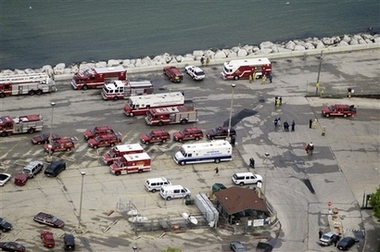Americas
Medical plane crashes in Lake Michigan
(AP)
Updated: 2007-06-06 01:00
 |
Large Medium Small |
Searchers found human remains during a search in Lake Michigan, where the plane went down Monday night about six miles northeast of Milwaukee, a Coast Guard official said.
|
"The condition of the aircraft debris and human remains found indicate a high-speed impact," Coast Guard Capt. Bruce Jones said. "We believe this to have been a non-survivable crash."
The team's lifesaving mission — carrying unspecified organs from Milwaukee for transplant to a patient in Michigan — was cut short when the Cessna Citation went down in 57-degree water shortly after the pilot signaled an emergency.
Those on board were two surgeons and two donor specialists from the University of Michigan Health System and two pilots who regularly fly their transplant missions.
Dr. Darrell A. Campbell, chief of staff of the University of Michigan Hospitals and Health Centers, said the thoughts of the university community were with the families of those involved.
"We take consolation in the fact that the team was on a mission to help another," he said.
The patient who was to have received the transplant organs was in critical condition, the university said. Jay Campbell, executive director of the Wisconsin Donor Network, declined to say which hospital the team was working with, citing privacy regulations.
The first human remains were found late Monday but hadn't been identified, Jones said. Divers stopped searching at nightfall, while crews of a Coast Guard boat and helicopter continued searching using night vision goggles
Only small parts of the plane had been found so far, Jones said.
Jones said they wouldn't speculate on the crash's cause. The National Transportation Board was expected to arrive later Tuesday.
There were 55 accidents involving emergency medical services flights — those carrying patients or organs for transplant — between January 2002 and January 2005, according to the most recent National Transportation Safety Board study on the issue. The study found several safety problems, including less stringent requirements for EMS flights that did not carry patients.
The president of the United Network for Organ Sharing, the national organization that coordinates organ transplants, issued a statement calling the transplant team "unsung heroes" even as she said privacy rules prevented the group from sharing information about the flight and transplant.
"Every day, thousands of professionals do their very best to ensure that the donation and transplantation process is successful," Dr. Sue V. McDiarmid said. "Because of their routine success, the public may not understand the risks they sometimes must take in recovering and transporting organs. They are unsung heroes, willing to take these risks for the purpose of saving lives."
The university identified those aboard the plane as: Dr. Martinus "Martin" Spoor, a cardiac surgeon who had been on the faculty since 2003; Dr. David Ashburn, a physician-in-training in pediatric cardiothoracic surgery; Richard Chenault II, a transplant donation specialist with the university transplant program; Richard Lapensee, a transplant donation specialist with the university transplant program; and pilots Dennis Hoyes and Bill Serra.
The plane took off from General Mitchell International Airport in Milwaukee and was headed for Willow Run airport near Detroit, a 42-minute flight, Federal Aviation Administration spokesman Tony Molinaro said.
Just minutes after takeoff, the pilot declared an emergency and requested a return to Mitchell, Molinaro said. But the plane dropped off radar screens just after the pilot made that request and the Coast Guard was contacted.
Light rain was falling at the airport with wind of 12 mph, gusting to 22 mph, according to J.J. Wood, a National Weather Service meteorologist.
The plane was leased by the University of Michigan Health System in Ann Arbor, according to the university. It's owned by Toy Air and based at Willow Run Airport in Ypsilanti, Mich.
| 分享按钮 |

